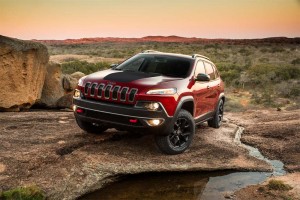
Even while waiting for the launch of the new Jeep Cherokee, Chrysler has seen sales continue to grow, month over month.
Despite Wall Street’s unexpected setbacks and other concerns about the economy, when all the sales numbers are tabulated and reported tomorrow, Chrysler expects June will have brought another month of sales growth.
Reid Bigland, head of U.S. sales for Chrysler, said that despite having one key plant sidelined for model change and deliberate cuts in fleet sales, Chrysler expects June will bring the maker’s 39th consecutive month of year-over-year sales growth in the U.S. and 43rd consecutive month of sales gains in Canada.
“We’ve seen it pretty consistent,” said Bigland, who also oversees the Ram brand, during an interview at the Chrysler proving grounds in Chelsea, Michigan. “I would say good, not weak, not great, just kind of good, in the month of June,” added Bigland.
That’s despite the problems the maker has had with its Jeep brand.
For one thing, it is still ramping up production of the 2014 Jeep Grand Cherokee. Meanwhile, Chrysler shut down production of the Jeep Liberty at its assembly complex in Toledo, Ohio last December as it began retooling for the launch of the newly revived Jeep Cherokee model.
“The Liberty has really hurt,” Bigland said “We start every month 7,000 or 8,000 units in the hole. Certainly not having a mid-size SUV leave us at a deficit.”
(For more on the new Jeep Cherokee, Click Here.)
While Cherokee production is beginning to get up to speed at the Toledo plant, none of the new Jeeps – which will compete with such strong players as Toyota’s popular RAV4 and the Honda CRV — have been shipped to dealers, yet, Bigland said.
Further cutting into Chrysler’s June numbers, the make has been planning to reduce its fleet sales by between 25,000 and 30,000 units this summer while putting more emphasis on the higher-profit retail side of the market. The ultimate reduce fleet sales to roughly 21% of Chrysler’s total sales.
“We’ve got to continue to work our game plan,” said the Chrysler marketing chief. So far, the maker has been able to make up the lost volume with strong sales “right across the board,” Bigland said. Through May, Chrysler’s sales are up 9%, beating the industry-wide 7.3% increase for the first five months of 2013.
(June auto sales continue to gain momentum despite stock market stumbles. Click Here for more.)
Sales of the rest of the Jeep sport-utility line, as well as the new Dodge Dart have all contributed to the increase. But Chrysler has seen a particularly strong surge in demand for its Ram pickups which gained 23% in the first five months of the year, mimicking similar increases for large pickups at General Motors and Ford.
While there appears to be some renewed growth in the so-called personal use segment of the pickup market, the real gains are coming in the work truck segment, noted Bigland, and appear to be following the turnaround of the U.S. construction industry. Contractors and home builders are among the most dedicated of buyers for full-size pickups when the economy is strong.
Mike Manley, president of the Jeep brand, meanwhile told reporters in Chelsea he expected the brand’s SUV sales to exceed the 700,000 units Jeep sold in 2012 despite the shutdown of Liberty production. The new Cherokee will be ready for sale in late August or early September and some units will be exported to China before the end of the years. Next year, Jeep sales should top 800,000 units, he said.
(Jeep bows to NHTSA pressure – but recall smaller than originally planned. Click Here for more.)
The strong surge for Jeep, Ram and Chrysler’s brands suggest that the underlying fundamentals in the U.S. market are relatively strong, sales chief Bigland stressed.
“There’s been a tremendous amount of volatility,” he suggested. “But the economy is objectively getting better. Unemployment is still stubborn but it’s better than it’s been. In addition, the housing market is showing new signs of life and other fundamentals, such as credit and the availability of credit, have moved into positive territory.
Bigland did express concerns about the Japanese government’s effort to devalue the yen.
“That market is fundamentally closed just like the South Korean market is fundamentally closed,” he noted. “I’ve seen some pretty aggressive pricing moves from one fella and they popped some pretty good numbers,” he said.
